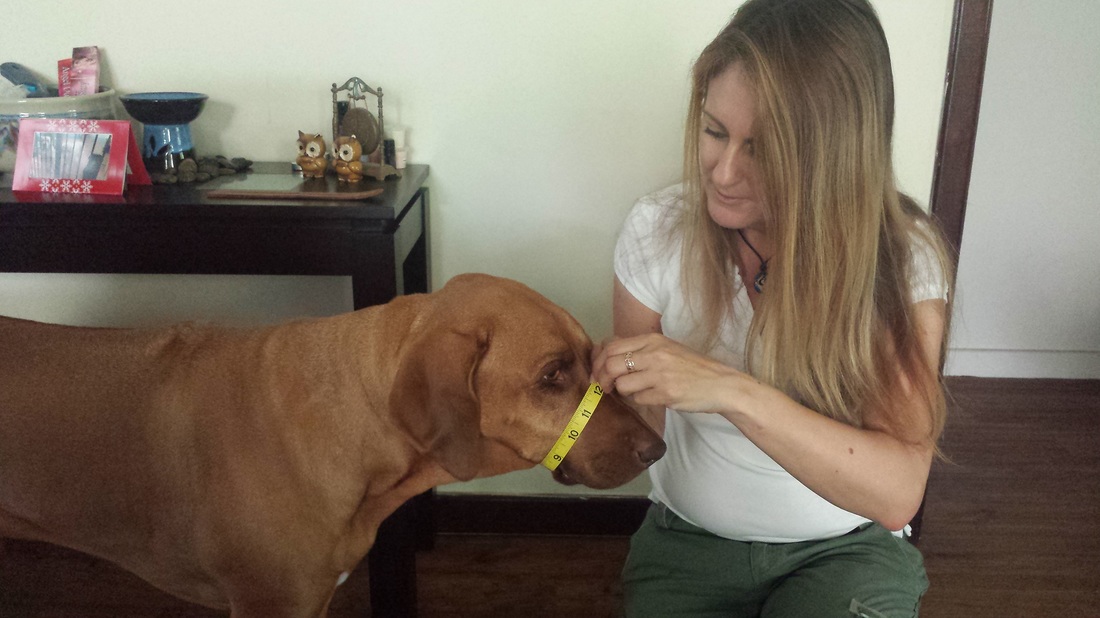
It is really important to me that the animal is showing signs of wanting to engage. Further, I want to engender an attitude of joy in the trainee. I want it to be fun for the learner. There is a wonderful by-product of creating an enjoyable learning experience – the trainer is associated with the positive experience. The trainer is the source of all good things, someone to keep an eye on, to gravitate towards. The trainer is consistent, to be trusted and not feared. The trainer is a good communicator, not confusing or a source of stress. This is a huge factor in relationship building.
I was challenged when I reviewed video footage of a training session I had with Zuri. I wanted to measure her nose for a muzzle. I hadn’t done this before and Zuri is hesitant with new things (enter the tape measure) and handling. “This would make a great video topic”, I thought. What a great way to show a functional use of a well taught ‘touch’ and ‘wait’ with a reluctant dog. It would also demonstrate how seamlessly a dog can learn something new if they have a history of learning other tasks and playing training games that are enjoyable. Off I went and duly measured Zuri’s nose in front of the camera. It got the job done quickly, in less than two minutes. When I watched the footage back, I was disappointed. On the surface it looked pretty good: no physical restraint or enviromental restraint (like backing a dog into a corner), no force, no struggle, no harsh words or physical intimidation, no avoidance by seeking distance or walking away on Zuri’s part. Yet it lacked enthusiasm. It lacked the joyful demeanour of a softly wagging tail. Where was the anticipation and engagement with gusto? I even noted some subtle signs of stress such as repeated blinking, paucity of movement, head turning away from me and the tape measure, drawing the head away from the tape measure and, because I know her body language so well, even the slight tension in her floppy ears as they pulled backwards and close to her head just a few millimetres. She was licking her lips at times. I wasn’t sure if this was due to the food or a sign of stress, but I suspected stress. She wasn't wagging her tail.
I was simply too focused on getting the job done: the job being showing how ‘touch’ and ‘wait’ were so cool for teaching other tasks. I wasn’t using overt force but I was pushing her into a level of discomfort and I was lucky she was staying despite this.
What I didn’t like:
* I was doing it slowly, but not slow enough. Instead of breaking the process down into small enough steps, I was jumping straight from presenting the tape measure to touching her with it.
* My hands were moving towards her with the tape, rather than giving her the option of approaching. That’s a big deal for animals: to have options of when to engage and disengage. When an animal feels safe, they will be more compliant. Part of feeling safe for an animal is having the ability to stop the process at any time.
* When she looked away, I prompted her to touch my hand instead of waiting for her signal that she was ready to continue. (All because I wanted to demonstrate ‘touch’!)
* I asked her to ‘wait’ and then held the measuring tape on for too long. I should have been quicker to remove it and built up the duration gradually.
This just wouldn’t do. The functional goal had been met but the journey could have been much better for Zuri. She's my bud and this matters to me. So I did it again the next day with the goal to get footage of Zuri engaged with obvious enjoyment. One of my favourite catch phrases is, “Our behaviour changes a dog’s behaviour”. I changed what I was doing ever so subtly.
* I broke the process down into even smaller steps. There were quite a few in between showing the tape and wrapping it for a few seconds around her nose to measure.
* Breaking down the process into smaller steps resulted in being able to give a higher rate of reinforcement which is a sure way to get an enthusiastic learner.
* I let her approach the tape rather than put it on her nose.
* If she looked away, I didn’t ask for a ‘touch’. I waited until she was ready.
* I threw treats away from me and let her return in her own time to look for the measuring tape.
* I was more relaxed and my body language was more playful, not so darn serious!
The difference was noticeable. Her tail was wagging, her body soft, she was eager to engage and find the tape even when I hid it from view. Her floppy ears were pivoting forward more. The lip licking that was present in the first video was greatly reduced in the subsequent footage. The blinking reduced.
I got the behaviour required for taking measurements and then just kept on playing the game because we were both enjoying the moment. It took about one and a half minutes. That said, how long it takes is less of an issue to me than how much fun it is. I make mention because many people believe that it's too time consuming to approach dog handling in this way and therefore resort to physical restraint. I will add that if you do not have a solid trust account with your dog, it will take longer.
Approaching handling this way is a delightful journey where both participants enjoy the ride.
Email subscribers can watch our journey here.

 RSS Feed
RSS Feed